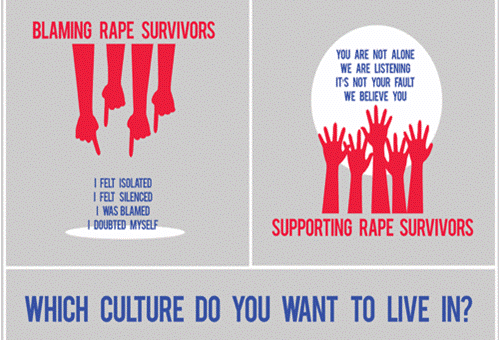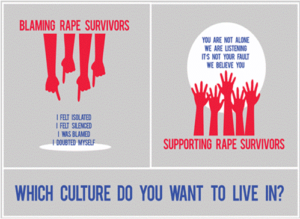
5 Ways that Victim-Blaming Fails Survivors of Sexual Assault
Post by Zoë B
Why does sexual assault happen? How could someone do something so horrible to another human being? How do we make sense of this, especially when it happens to someone we know or love – or to ourselves?
These are many of the questions that people may struggle with when thinking about rape and sexual assault in our society. Many of us look for “answers” when it comes to sexualized violence – we want to know why it happens, who it happens to, and what should be done to prevent it. Unfortunately, a quest for clear and easy answers often leads to blaming victims of sexual assault for the violence perpetrated against them. Widespread myths about rape are often referenced, such as that a woman who is dressed a certain way, is in a sexual relationship with the perpetrator, is drinking, or has consented to sex with the perpetrator in the past is somehow “asking for it”. This process is called victim-blaming, and it is one of the many ways that our society fails survivors of sexualized violence.
So why and how does victim-blaming fail survivors? Below are just a few examples:
- Victim-blaming can cause additional trauma to survivors, because it burdens them with guilt, shame, and the impossible responsibility to prevent violence that others choose to commit. Myths about sexual assault are repeatedly circulated online, in the media, in courts, and by those in positions of power. After experiencing sexual assault and trauma, the last thing any survivor needs is to feel ashamed. Instead, survivors should feel believed and supported. They should be reassured that all survivors respond differently to sexualized violence, and that they have the right to choose their own path to healing and justice.
- At WAVAW, we know that connection is healing. Survivors who are blamed for their assaults face huge barriers to seeking connection and support – the very thing that is so important to many survivors’ healing journeys. As Dalya Israel, Manager of Victim Service and Outreach at WAVAW has stated, “The barriers to reporting sexual assault are [supported] by how we are socialized to think about sexual assault. It is still common for society to blame victims and question what women did to prevent their own rape. Women internalize these barriers [that then] become obstacles to getting support from the people they love let alone speaking to the police…women internalize shame from living in a culture that blames victims.”
- Victim-blaming in our communities, media, and criminal-legal system often prevents survivors from accessing justice. As Marianne from xoJane states, “People who report rape — especially women who belong to vulnerable populations (women of color, poor women, disabled women, trans women, very young women – not to mention people who live at the intersections of these identities) – are scrutinized in our courts and in our popular media. To report a rape can mean being further victimized by not just the victim-blaming system but also by the support structures we thought we had in place, like friends and family and school social circles.” We see this in situations such as a Canadian Judge Robin Camp telling a survivor she could have “just keep her legs together” to prevent her sexual assault, or the intense scrutiny and blame placed on the many survivors of Jian Ghomeshi’s sexual violence.
- Victim-blaming also fails survivors because it leads to higher acquittal rates for perpetrators of violence. Conviction rates for sexual assault are significantly lower than for other violent crimes. From 2014-2017, only 3.1% of WAVAW’s 717 Victim Service clients saw their perpetrators convicted. In our court system, survivors who chose to report may find themselves facing intense scrutiny and cross-examination regarding any number of rape myths – a process that is designed to shed reasonable doubt on their testimonies. At WAVAW, we know that survivors are never to blame for the violence perpetrated against them, and that our criminal justice system and other powerful institutions must also be held accountable for perpetuating this violence.
- Finally, victim-blaming fails survivors because it avoids addressing the real root causes of violence. Women, trans, Two Spirit, and gender diverse folks experience high rates of assault because we live in a culture that views these populations as less valuable than cisgendered men. In addition to sexism, factors like racism, colonization, homophobia, transphobia, classism, fatphobia, and ableism all contribute to violence against women and LGBTQIA+ folks. It is these factors, not the way a survivor looks or acts, that causes us to be targeted for violence.
 At WAVAW, we know that the root causes of sexualized violence are the individual choices that perpetrators make, as well as the systems, institutions, and people in positions of power that fail to challenge the rape culture we all live in. Instead of searching for a false sense of security by blaming victims, we must address the root causes of violence by dismantling rape myths and holding institutions and individual perpetrators accountable. Survivors are never to blame for the violence perpetrated against them, and these systems, individuals, and institutions must be held accountable if we are to truly end all forms of violence in our communities.
At WAVAW, we know that the root causes of sexualized violence are the individual choices that perpetrators make, as well as the systems, institutions, and people in positions of power that fail to challenge the rape culture we all live in. Instead of searching for a false sense of security by blaming victims, we must address the root causes of violence by dismantling rape myths and holding institutions and individual perpetrators accountable. Survivors are never to blame for the violence perpetrated against them, and these systems, individuals, and institutions must be held accountable if we are to truly end all forms of violence in our communities.
So the next time we are struggling to make sense of sexualized violence, let us consider how victim-blaming not only fails survivors, but all of us.
- On December 7, 2017

